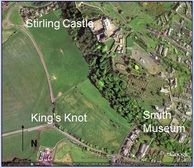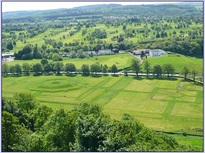The King’s Knot, Stirling: Geophysical and Topographic Survey
Stephen Digney, Adrián Maldonado, Richard Jones and Tessa Poller
Stirling Local History Society, Stirling Field and Archaeological Society, Archaeology University of Glasgow
Stirling Local History Society, Stirling Field and Archaeological Society, Archaeology University of Glasgow
|
The King’s Knot, known locally as the ‘cup and saucer’, is a popular Stirling landmark located below and to the south of Stirling Castle (Fig. 1) within the King’s Park. It consists of a stepped octagonal mound set within a square parterre, and to the north-west is a second (much smaller) low circular mound also set within a square parterre (Fig. 2). These conspicuous earthworks represent the final form of the royal gardens of Stirling Castle, and were constructed for Charles I in 1627-9 (RCAHMS 1963: 219).
Viewed from the castle above, James IV had earlier created in the 1490s a landscape of leisure with his park, loch, fish ponds and great garden of fruit trees, flowers and hedges which came close to the garden ideal of the Italian Renaissance. The garden was maintained throughout the 16th and 17th centuries, before falling into decay. Although considered the most important pre-1600 garden in Scotland, and the subject of much speculation, the King’s Knot has received very little archaeological attention. Aerial photographs taken in 1980 (by the Royal Commission for Ancient & Historical Monuments of Scotland) however made an important discovery: three concentric ditches in a trapezoidal form beneath and around the King’s Knot mound suggested that an earthwork monument had preceded it. Is this the 'round table' mentioned by Barbour in the 14th century, or is it an earlier prehistoric monument? In May-June 2011 local society volunteers and a team from Glasgow University’s Archaeology Department carried out geophysical (Fig. 3a-c) and topographic (Fig. 3d) surveys with the aim of exploring King’s Knot more fully, combining the results with the aerial photographs together with historical research to produce a comprehensive record of the King’s Knot. The results of the geophysical surveys are very encouraging. The project acknowledges with gratitude funding received from the Stirling City Heritage Trust and Historic Scotland, and the support of the Stirling Smith Art Gallery and Museum. |
|





